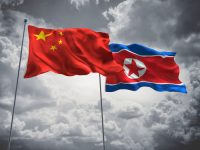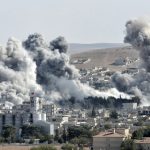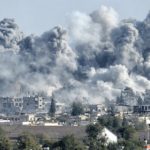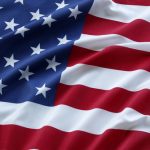Is War Looming with China and North Korea?

Veteran documentary maker John Pilger’s new film the Coming War on China screened on television last Sunday night. In it, Pilger “breaks the silence” on the US government’s recent military build-up that’s aimed directly at China.
The Australian journalist explains that the US has succeeded in virtually encircling China in “a perfect noose” of 400 military bases, along with warships, bombers and missiles. And this intensification of military might has nothing to do with the Trump administration.
The US “pivot to Asia” began in 2011. It was launched by then-president Barack Obama, and according to Pilger, it’s “the biggest build-up of US air and naval forces in the Asia-Pacific region since the Second World War.”
The great wall of sand
There’s also growing tensions in the South China Sea. Over recent years, China has been constructing a series of artificial islands, with military capabilities, upon partly-submerged reefs in the contested Spratlys archipelago. Beijing claims sovereignty over the majority of the sea.
The US has responded by conducting so-called “freedom of navigation” operations, running warships through the disputed waters. While China’s actions in the region are reported as aggressive, Pilger points to the threat the US build-up poses as the reason behind the move.
US victory is achievable at present
Mr Pilger is not the only voice warning of a pending war with China. A Rand Corporation analysis for the US Army mentioned the possibility of such a war, saying it would be “intense, destructive and protracted.”
The recently released report predicts that the US could win a war now, because it currently possesses the technological edge. However, things could be different by 2025, as China’s military capabaility develops.
The corporation noted that war with China is not imminent, but a number of tentative issues exist between the two countries.
The Rand Corporation is a conservative, independent think tank that was set up in 1948 to look into the long-range planning of future weapons. The majority of its funding comes from the US defence forces and the health department.
Dinner talk of Tomahawk missiles
There’s been a lot of speculation made about warming relations between the United States and China since Chinese president Xi Jinping’s official visit to the US earlier this month.
But it must be remembered that during that visit, president Donald Trump told Mr Xi that he’d just launched an airstrike on the government-controlled Shayrat airbase in Syria, as the two of them were eating dessert at his Mar-a-Lago estate in Florida.
As the pair enjoyed what Trump described a “the most beautiful piece of chocolate cake,” many feel announcement came across as a veiled threat of US military might.
Warships on the Korean Peninsula
Just a few days after the diplomatic dinner, the Trump administration turned its attention towards China’s neighbouring ally North Korea.
On April 9, the US government announced it was sending an armada of American warships to the Korean Peninsula, in response to North Korea’s intensification of its nuclear and ballistic missile programs.
Pyongyang has recently been testing missiles directed towards the Sea of Japan. And it’s been reported that the country is also gearing up to test another nuclear device, its sixth such test since 2006.
The US president has warned that his country is prepared to act alone in dealing with the nuclear threat posed by North Korea, meaning if China doesn’t to do anything about the pariah state, then they will.
The threat of nuclear war
Since the US has taken aim at North Korea, the hostilities are ever increasing. Last Saturday, Pyongyang carried out another missile test which failed. The missile exploded four to five seconds after launching.
The failed test took place at the same time that US vice president Mike Pence was making his way to South Korea on a diplomatic visit. Pence visited the demilitarised zone – the area between North and South Korea – and remarked that his nation’s “era of strategic patience” was over with Pyongyang.
The US and South Korea began a joint air force military exercise on Monday called Max Thunder.
Responding to the military drill, North Korea’s deputy UN ambassador, Kim In-ryong warned the US was creating “a dangerous situation in which a thermonuclear war may break out at any moment.”
The pressure on China
The Trump administration has been pushing China to take action to bring about a North Korean policy change. The US vice president said that Trump had made it very clear that “either China will deal with this problem or the United States and our allies will.”
The US military are currently stationed in the sea close to mainland China. They’ve positioned navy ships in the region threatening the nation that was allied with China during the Korean War, and they’re carrying out military exercises with South Korean forces, Beijing’s enemy in that conflict.
In light of the US military build-up Pilger describes in the Asia-Pacific region, this newly developing situation could be easily taken by the Chinese Communist Party, as hostility pointed in their direction.
China has announced that it has sought to enlist Russia in the hope of diplomatically cooling down the situation in the Korean Peninsula. However, there are persistent rumours that China is sending an extra 150,000 troops to its North Korean border.
So what could this mean for Australia?
Pine Gap, the secretive US military intelligence base, has been operating in Australia since the 1960s. It plays a key role in US operations throughout the world. The US warned Australia last week that any escalation in a conflict with North Korea could make the central Australian spy base a target.
Australian foreign minister Julie Bishop told the ABC on Tuesday that North Korea’s nuclear program poses “a serious threat” to Australia, and said that she supports the US strategy in the region. She added that a North Korean missile could potentially strike Australia if they were allowed to continue with their program.
However, Pilger has written that there’s a very real danger that Australia could become embroiled in a confrontation with China. One example he gives for this is the country’s continued involvement in the biennial Operation Talisman Sabre, a joint military exercise with the US.
The operation, which is carried out in locations including northern and central Australia, is set take place again this July. The military exercise has been criticised in the past as being a preparation for war with China.
As Trump signals that he is willing to make greater trade terms with China, if Beijing puts the pressure on Pyongyang to halt its weapons programs, it’s hard to know just what political rhetoric should be believed.
But one question that needs to be asked is whether Australia really wants to follow the rogue United States into a conflict with either North Korea or the People’s Republic of China?







